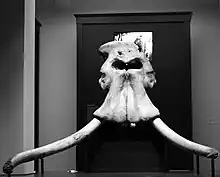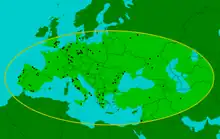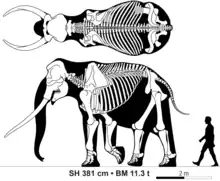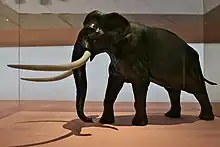Straight-tusked elephant
The straight-tusked elephant (Palaeoloxodon antiquus) is an extinct species of elephant that inhabited Europe and Western Asia during the Middle and Late Pleistocene (781,000–30,000 years Before Present). Recovered individuals have reached up to 3.81–4.2 metres (12.5–13.8 ft) in height, and an estimated 11.3–15 tonnes (11.1–14.8 long tons; 12.5–16.5 short tons) in weight. Like modern elephants, the straight-tusked elephant lived in herds, flourishing during interglacial periods, when its range would extend as far north as Great Britain. Skeletons found in association with stone tools and wooden spears suggest they were scavenged and hunted by early humans, including Neanderthals. It is the ancestral species of most dwarf elephants that inhabited islands in the Mediterranean.
| Straight-tusked elephant Temporal range: Mid-Late Pleistocene ~ | |
|---|---|
.JPG.webp) | |
| Skeleton in Rome | |
 | |
| Skull in Germany | |
| Scientific classification | |
| Domain: | Eukaryota |
| Kingdom: | Animalia |
| Phylum: | Chordata |
| Class: | Mammalia |
| Order: | Proboscidea |
| Family: | Elephantidae |
| Genus: | †Palaeoloxodon |
| Species: | †P. antiquus |
| Binomial name | |
| †Palaeoloxodon antiquus | |
 | |
| Approximate range of P. antiquus | |
| Synonyms | |
|
Elephas antiquus (Falconer & Cautley, 1847)
| |
Description


Like many other members of the genus Palaeoloxodon, P. antiquus possesses a well developed parieto-occipital crest at the top of the cranium that anchored the splenius as well as possibly the rhomboid muscles to support the large head, the largest proportionally and in absolute size among proboscideans. Two morphs of P. antiquus were previously suggested to exist in Europe on the basis of parieto-occipital crest variation, one more similar to P. namadicus, but these were shown to be the result of ontogenetic variation and taphonomic distortion. P. antiquus can be distinguished from the Indian P. namadicus based on its less stout cranium and more robust limb bones.[2] The premaxillary bones (which contain the tusks) are fan-shaped and very broad in front-view. The tusks are very long relative to body size and vary from straight to slightly curved. The forelimbs of P. antiquus, particuarly the humerus and scapular, are proportionally longer than those of African bush elephants. The head represents the highest point of the animal, with the back being sloped, with most of the spines of the back vertebrae being long. The body (including the pelvis) was broad relative to extant elephants. The tail was shorter than that of extant elephants, but longer than that of the woolly mammoth. Although not preserved, the body was probably only sparsely covered in hair, similar to extant elephants, and probably had large ears.[3]
As with modern elephants, the species was sexually dimorphic, with males being substantially larger than females.[3] P. antiquus was on average considerably larger than any living elephant. In a 2015 study, one approximately 40-year-old male specimen of P. antiquus from Viterbo in Italy was estimated at about 3.81 metres (12.5 ft) tall at the shoulders and estimated to weigh about 11.3 tonnes (11.1 long tons; 12.5 short tons), while a fragmentary specimen including the humerus from Montreuil, France, was estimated to weigh about 15 tonnes (14.8 long tons; 16.5 short tons) and be 4.2 metres (13.8 ft) tall at the shoulder. The average male has been estimated to have had a shoulder height of 4 m (13.1 ft) and a weight of 13 tonnes (12.8 long tons; 14.3 short tons).[4] Females probably only reached a height of about 3 metres and weight of 5.5 tonnes (5.4 long tons; 6.1 short tons).[3] A largely complete 5 year old calf from Cova del Rinoceront in Spain was estimated to have a shoulder height of 178–187 centimetres (5.8–6.1 ft) and a body mass of 1.45–1.5 tonnes (1.43–1.48 long tons; 1.60–1.65 short tons), which is comparable to a similarly aged African bush elephant.[5]
Taxonomy
The species was first named in 1847 by Hugh Falconer and Proby Cautley for remains found in East Sussex as Elephas antiquus.[6] The genus Palaeoloxodon was first named in 1924 by Matsumoto Hikoshichirō as a subgenus of Loxodonta, and E. antiquus subsequently assigned to the genus.[7] Some experts regarded the larger Asian species Palaeoloxodon namadicus as a variant or subspecies,[8] but they are now considered distinct.[2] Historically, the genus Palaeoloxodon has at times been regarded as a subgenus of Elephas, but a 2007 study of hyoid characteristics amongst living and fossil elephants has largely led to an abandonment of this hypothesis.[9]
In 2016, a mitochondrial DNA sequence analysis of P. antiquus suggested that its closest extant relative was the African forest elephant (L. cyclotis). The paper found that the mitochondrial genome of P. antiquus is closer to L. cyclotis than L. cyclotis is to the African bush elephant, L. africana, which the authors of the paper suggested may invalidate the genus Loxodonta as currently recognized.[10][11] A subsequent study published by Palkopoulou et al. (2018) based on the nuclear genome indicated a more complicated relationship between straight-tusked elephants and other species of elephants; according to this study, the biggest genetic contribution to straight-tusked elephants comes a lineage of elephants that was most closely related but basal to the common ancestor of forest and bush elephants (~60% of total genomic contribution), which hybridized with African forest elephants (>30%) and to a lesser extent with mammoths (~5%). The African forest elephant ancestry was more closely related to modern West African forest elephants than to other African forest elephant populations. This hybridisation likely occurred in Africa, prior to migration of Palaeoloxodon into Eurasia,[12] and is likely shared with other Palaeoloxodon species.[13]
Evolution
Like other Eurasian Palaeoloxodon species, P. antiquus is believed to derive from the African P. recki. P. antiquus first appears during the early Middle Pleistocene, with its first records around 780,000 years ago in Italy and Israel. Its earliest known appearance in northern Europe is in England around 600,000 years ago. Its arrival coincided with the replacement of Mammuthus meridionalis by Mammuthus trogontherii. There appears to be no overlap between M. meridionalis and P. antiquus, which suggests that the latter might have outcompeted the former. During P. antiquus's hundreds of thousands of years of existence, its morphology remained relatively static, unlike European mammoth populations.[14]
Range
P. antiquus is known from abundant finds across Europe, ranging as north as Great Britain and as far east as European Russia during interglacial periods. Fossils are also known from Israel, Iran and probably Turkey in West Asia, and also possibly from Kazakhstan and Tajikistan. During glacial periods P. antiquus permanently resided in the Mediterranean region.[15][16] It is primarily associated with temperate and Mediterranean forest and woodland habitats, as opposed to the colder open steppe environments inhabited by contemporary mammoths.[17] Many of the remains attributed to the species from Western Asia are primarily done so for geographical reasons, and it has been suggested that some of these specimens may have closer affinities with P. recki.[18]
Behaviour
As with modern elephants, female and juvenile straight-tusked elephants are thought to have lived in matriarchal herds of related individuals, with the adult males living solitary lives. Like modern elephants, the herds would have been restricted to areas with available fresh water due to the greater hydration needs and lower mobility of the juveniles.[19]
Dental microwear studies suggest that the diet of P. antiquus was highly variable according to the local conditions, ranging from almost completely grazing to nearly totally browsing, though microwear only reflects the diet in the last few days or weeks before death, so this may be reflecting seasonal dietary variation. A 2016 dental mesowear study of specimens from Britain found that most examined specimens had a browsing predominant mixed feeding diet, with clear niche separation from the more grazing dominated diet of the contemporary Mammuthus trogontherii.[20][21]
Relationship with humans
Remains of straight-tusked elephants at numerous sites are associated with stone tools and/or bear cut and percussion marks indicative of butchery. In the case of most sites, it is unclear whether the elephants were hunted or were scavenged.[22][23] These include the Gesher Benot Ya'akov[24] (c. 780 kya,[25] though other authors attribute the remains to P. recki[2]) and Revadim Quarry[26] (sometime between 780 kya and 300-500 kya[25]) sites in Israel, the Ambrona AS3[27] (MIS 12 c. 478-425 kya) , Aridos 1 (MIS 11-9 424-300 kya) & 2[28] (MIS 11 c. 425-375 kya) sites in Spain, the Notarchirico[29] (c. 670-610 kya[25]), Ficoncella[30] (c. 500 kya), Castel di Guido[31][32][33] (c. 400 kya[33]), La Polledrara di Cecanibbio (325–310 kya)[25] and Poggetti Vecchi (c. 171 kya)[34] sites in Italy, the Marathousa 1 site (c. 500-400 kya)[35] in Greece, the Schöningen (c. 300 kya)[36] and Gröbern (c. 130-115 kya)[22] sites in Germany, and the Ebbsfleet site (c. 425-375 kya) in England.[37] The creation of these sites is likely attributable to Homo heidelbergensis and Neanderthals.[23] Stone tools used at these sites include flakes, choppers, bifacial tools like handaxes, as well as cores.[23] At some sites, the bones of straight-tusked elephants were used to make tools.[33] At the Lehringen site in north Germany, dating to the last interglacial (Eemian, ~130-115,000 years ago) a skeleton of P. antiquus was found with a spear made of yew wood between its ribs, with flint artifacts found close by.[38][22] A 2023 study proposed that remains accumulated during the Eemian in Neumark Nord, Germany, were the result of hunting by Neanderthals, who the authors proposed were disproportionately targeting the solitary adult males. The authors reported the presence of numerous cut marks on the bones.[22] There is no evidence that straight-tusked elephants were exploited preferentially by early humans over other, smaller animals.[23]
There are no cave paintings that unambiguously depicts P. antiquus, though an outline drawing of an elephant in El Castillo cave in Cantabria, Spain, as well as a drawing from Vermelhosa in Portugal have been suggested to possibly depict it, but could also potentially depict woolly mammoths.[17][39]
Extinction
P. antiquus retreated from northern Europe at the end of the Eemian interglacial, and fossils after that time are rare. A molar from Grotta Guattari in Italy has been suggested to date to around 57,000 years ago (though other studies have found it to have a slightly older early Late Pleistocene age), with other remains from the Iberian Peninsula dating from 50-40,000 years ago, and possibly as late as 34,000 years ago based on a tooth found at Foz do Enxarrique in Portugal.[40][17] A late date of around 37,400 years ago has been reported from a single molar found in the North Sea off the coast of the Netherlands,[41] but other authors have suggested that this date needs independent confirmation.[42] A 2020 study suggested that P. antiquus likely survived until around 28,000 years ago in the southern Iberian Peninsula, based on footprints found in Southwest Portugal and Gibraltar. Its extinction is likely to be due to climatic deterioration, possibly in association with hunting.[43]
Dwarfed descendants
Dwarf elephants that presumably evolved from the straight-tusked elephant are known from many Mediterranean islands, spanning from Sicily and Malta in the west to Cyprus in the east.[40] The responsible factors for the dwarfing of island mammals are thought to be the reduction in food availability, predation and competition.
References
- Benoit, J., Legendre, L. J., Tabuce, R., Obada, T., Mararescul, V., & Manger, P. (2019). Brain evolution in Proboscidea (Mammalia, Afrotheria) across the Cenozoic. Scientific Reports, 9(1), 9323. https://doi.org/10.1038/s41598-019-45888-4
- Larramendi, Asier; Zhang, Hanwen; Palombo, Maria Rita; Ferretti, Marco P. (February 2020). "The evolution of Palaeoloxodon skull structure: Disentangling phylogenetic, sexually dimorphic, ontogenetic, and allometric morphological signals". Quaternary Science Reviews. 229: 106090. Bibcode:2020QSRv..22906090L. doi:10.1016/j.quascirev.2019.106090. S2CID 213676377.
- LARRAMENDI, Asier; PALOMBO, Maria Rita; MARANO, Federica (2017). "Reconstructing the life appearance of a Pleistocene giant: size, shape, sexual dimorphism and ontogeny of Palaeoloxodon antiquus (Proboscidea: Elephantidae) from Neumark-Nord 1 (Germany)" (PDF). Bollettino della Società Paleontologica Italiana (3): 299–317. doi:10.4435/BSPI.2017.29. ISSN 0375-7633.
- Larramendi, A. (2016). "Shoulder height, body mass and shape of proboscideans" (PDF). Acta Palaeontologica Polonica. 61. doi:10.4202/app.00136.2014. S2CID 2092950.
- Palombo, Maria Rita; Sanz, Montserrat; Daura, Joan (December 2021). "The complete skeleton of a straight-tusked elephant calf from Cova del Rinoceront (Late Pleistocene, NE Iberian Peninsula): New insights into ontogenetic growth in Palaeoloxodon antiquus". Quaternary Science Reviews. 274: 107257. Bibcode:2021QSRv..27407257P. doi:10.1016/j.quascirev.2021.107257. S2CID 244088519.
- Hugh Falconer and Proby Thomas Cautley: Fauna antiqua Sivalensis
- 松本彦七郎 (1924). 日本産化石象の種類(略報) [Types of fossil elephants from Japan]. 地質学雑誌 (in Japanese). 31 (371): 255–272. doi:10.5575/geosoc.31.371_255.
- Mol, D., De Vos, J., Reumer, J.W.F., 1999. Praeovibos priscus (Bovidae, Artiodactyla, mammalia) from the North Sea and aspects of its paleoecology. In: Reumer, J.W.F., De Vos, J. (Eds.), 1999. Elephantshave a snorkel! Papers in Honour of Paul Y. Sondaar. Deinsea 7, 223–232.
- Shoshani, J.; Ferretti, M. P.; Lister, A. M.; Agenbroad, L. D.; Saegusa, H.; Mol, D.; Takahashi, K. (2007). "Relationships within the Elephantinae using hyoid characters". Quaternary International. 169–170: 174–185. Bibcode:2007QuInt.169..174S. doi:10.1016/j.quaint.2007.02.003.
- Callaway, E. (2016-09-16). "Elephant history rewritten by ancient genomes". Nature. doi:10.1038/nature.2016.20622. S2CID 89500906.
- Meyer, Matthias; Palkopoulou, Eleftheria; Baleka, Sina; Stiller, Mathias; Penkman, Kirsty E H; Alt, Kurt W; Ishida, Yasuko; Mania, Dietrich; Mallick, Swapan; Meijer, Tom; Meller, Harald; Nagel, Sarah; Nickel, Birgit; Ostritz, Sven; Rohland, Nadin; Schauer, Karol; Schüler, Tim; Roca, Alfred L; Reich, David; Shapiro, Beth; Hofreiter, Michael (6 June 2017). "Palaeogenomes of Eurasian straight-tusked elephants challenge the current view of elephant evolution". eLife. 6: e25413. doi:10.7554/eLife.25413. PMC 5461109. PMID 28585920.
- Eleftheria Palkopoulou; Mark Lipson; Swapan Mallick; Svend Nielsen; Nadin Rohland; Sina Baleka; Emil Karpinski; Atma M. Ivancevic; Thu-Hien To; R. Daniel Kortschak; Joy M. Raison; Zhipeng Qu; Tat-Jun Chin; Kurt W. Alt; Stefan Claesson; Love Dalén; Ross D. E. MacPhee; Harald Meller; Alfred L. Roca; Oliver A. Ryder; David Heiman; Sarah Young; Matthew Breen; Christina Williams; Bronwen L. Aken; Magali Ruffier; Elinor Karlsson; Jeremy Johnson; Federica Di Palma; Jessica Alfoldi; David L. Adelson; Thomas Mailund; Kasper Munch; Kerstin Lindblad-Toh; Michael Hofreiter; Hendrik Poinar; David Reich (2018). "A comprehensive genomic history of extinct and living elephants". Proceedings of the National Academy of Sciences of the United States of America. 115 (11): E2566–E2574. Bibcode:2018PNAS..115E2566P. doi:10.1073/pnas.1720554115. PMC 5856550. PMID 29483247.
- Lin, Haifeng; Hu, Jiaming; Baleka, Sina; Yuan, Junxia; Chen, Xi; Xiao, Bo; Song, Shiwen; Du, Zhicheng; Lai, Xulong; Hofreiter, Michael; Sheng, Guilian (July 2023). "A genetic glimpse of the Chinese straight-tusked elephants". Biology Letters. 19 (7). doi:10.1098/rsbl.2023.0078. ISSN 1744-957X. PMC 10353889. PMID 37463654.
- Lister, Adrian M. (2004), "Ecological Interactions of Elephantids in Pleistocene Eurasia", Human Paleoecology in the Levantine Corridor, Oxbow Books, pp. 53–60, ISBN 978-1-78570-965-4, retrieved 2020-04-14
- Pushkina, Diana (July 2007). "The Pleistocene easternmost distribution in Eurasia of the species associated with the Eemian Palaeoloxodon antiquus assemblage". Mammal Review. 37 (3): 224–245. doi:10.1111/j.1365-2907.2007.00109.x. ISSN 0305-1838.
- Albayrak, Ebru; Lister, Adrian M. (October 2012). "Dental remains of fossil elephants from Turkey". Quaternary International. 276–277: 198–211. Bibcode:2012QuInt.276..198A. doi:10.1016/j.quaint.2011.05.042.
- Braun, Ingmar M.; Palombo, Maria Rita (October 2012). "Mammuthus primigenius in the cave and portable art: An overview with a short account on the elephant fossil record in Southern Europe during the last glacial". Quaternary International. 276–277: 61–76. doi:10.1016/j.quaint.2012.07.010.
- Pokines, James T.; Lister, Adrian M.; Ames, Christopher J. H.; Nowell, April; Cordova, Carlos E. (March 2019). "Faunal remains from recent excavations at Shishan Marsh 1 (SM1), a Late Lower Paleolithic open-air site in the Azraq Basin, Jordan". Quaternary Research. 91 (2): 768–791. doi:10.1017/qua.2018.113. ISSN 0033-5894.
- Neto de Carvalho, Carlos; Belaústegui, Zain; Toscano, Antonio; Muñiz, Fernando; Belo, João; Galán, Jose María; Gómez, Paula; Cáceres, Luis M.; Rodríguez-Vidal, Joaquín; Cunha, Pedro Proença; Cachão, Mario; Ruiz, Francisco; Ramirez-Cruzado, Samuel; Giles-Guzmán, Francisco; Finlayson, Geraldine (2021-09-16). "First tracks of newborn straight-tusked elephants (Palaeoloxodon antiquus)". Scientific Reports. 11 (1). doi:10.1038/s41598-021-96754-1. ISSN 2045-2322. PMC 8445925. PMID 34531420.
- Saarinen, Juha; Lister, Adrian M. (October 2016). "Dental mesowear reflects local vegetation and niche separation in Pleistocene proboscideans from Britain: DENTAL MESOWEAR IN PLEISTOCENE PROBOSCIDEANS". Journal of Quaternary Science. 31 (7): 799–808. doi:10.1002/jqs.2906. S2CID 132421364.
- Rivals, Florent; Semprebon, Gina M.; Lister, Adrian M. (September 2019). "Feeding traits and dietary variation in Pleistocene proboscideans: A tooth microwear review". Quaternary Science Reviews. 219: 145–153. Bibcode:2019QSRv..219..145R. doi:10.1016/j.quascirev.2019.06.027. S2CID 200073388.
- Gaudzinski-Windheuser, Sabine; Kindler, Lutz; MacDonald, Katharine; Roebroeks, Wil (2023). "Hunting and processing of straight-tusked elephants 125.000 years ago: Implications for Neanderthal behavior". Science Advances. 9 (5): eadd8186. Bibcode:2023SciA....9D8186G. doi:10.1126/sciadv.add8186. PMC 9891704. PMID 36724231.
- Konidaris, George E.; Tourloukis, Vangelis (2021-04-14). "Proboscidea-Homo interactions in open-air localities during the Early and Middle Pleistocene of western Eurasia: a palaeontological and archaeolocigal perspective". Human-Elephant Interactions: From Past to Present. doi:10.15496/publikation-55599.
- N. Goren-Inbar, A. Lister, E. Werker, M.A. Chech A butchered elephant skull and associated artifacts from the Acheulian site of Gesher Benot Ya'aqov Israel Paléorient, 20 (1994), pp. 99-112
- Santucci, Ernesto; Marano, Federica; Cerilli, Eugenio; Fiore, Ivana; Lemorini, Cristina; Palombo, Maria Rita; Anzidei, Anna Paola; Bulgarelli, Grazia Maria (2016-06-25). "Palaeoloxodon exploitation at the Middle Pleistocene site of La Polledrara di Cecanibbio (Rome, Italy)". Quaternary International. VIth International Conference on Mammoths and their Relatives, Part 2. 406: 169–182. Bibcode:2016QuInt.406..169S. doi:10.1016/j.quaint.2015.08.042. ISSN 1040-6182.
- Rabinovich, R.; Ackermann, O.; Aladjem, E.; Barkai, R.; Biton, R.; Milevski, I.; Solodenko, N.; Marder, O. (October 2012). "Elephants at the Middle Pleistocene Acheulian open-air site of Revadim Quarry, Israel". Quaternary International. 276–277: 183–197. Bibcode:2012QuInt.276..183R. doi:10.1016/j.quaint.2012.05.009.
- Villa, Paola; Soto, Enrique; Santonja, Manuel; Pérez-González, Alfredo; Mora, Rafael; Parcerisas, Joaquim; Sesé, Carmen (2005-01-01). "New data from Ambrona: closing the hunting versus scavenging debate". Quaternary International. Studying Proboscideans: knowledge, Problems and Perspectives. Selected papers from "The world of Elephants" Congress, Rome. 126–128: 223–250. doi:10.1016/j.quaint.2004.03.001. ISSN 1040-6182.
- Yravedra, J.; Domínguez-Rodrigo, M.; Santonja, M.; Pérez-González, A.; Panera, J.; Rubio-Jara, S.; Baquedano, E. (October 2010). "Cut marks on the Middle Pleistocene elephant carcass of Áridos 2 (Madrid, Spain)". Journal of Archaeological Science. 37 (10): 2469–2476. Bibcode:2010JArSc..37.2469Y. doi:10.1016/j.jas.2010.05.007.
- The elephant butchery area at the middle Pleistocene site of Notarchirico (Venosa, Basilicata, Italy) G. Cavarretta, P. Gioia, M. Mussi, M.R. Palombo (Eds.), The World of Elephants. Proceedings of the First International Congress, Consiglio Nazionale delle Ricerche, Roma (2001), pp. 230-236
- Aureli, Daniele; Contardi, Antonio; Giaccio, Biagio; Jicha, Brian; Lemorini, Cristina; Madonna, Sergio; Magri, Donatella; Marano, Federica; Milli, Salvatore; Modesti, Valerio; Palombo, Maria Rita; Rocca, Roxane (2015-04-21). "Palaeoloxodon and Human Interaction: Depositional Setting, Chronology and Archaeology at the Middle Pleistocene Ficoncella Site (Tarquinia, Italy)". PLOS ONE. 10 (4): e0124498. Bibcode:2015PLoSO..1024498A. doi:10.1371/journal.pone.0124498. ISSN 1932-6203. PMC 4405345. PMID 25898322.
- Saccà, Daniela (October 2012). "Taphonomy of Palaeloxodon antiquus at Castel di Guido (Rome, Italy): Proboscidean carcass exploitation in the Lower Palaeolithic". Quaternary International. 276–277: 27–41. Bibcode:2012QuInt.276...27S. doi:10.1016/j.quaint.2012.03.055.
- Boschian, Giovanni; Saccà, Daniela (March 2015). "In the elephant, everything is good: Carcass use and re-use at Castel di Guido (Italy)". Quaternary International. 361: 288–296. Bibcode:2015QuInt.361..288B. doi:10.1016/j.quaint.2014.04.030.
- Villa, Paola; Boschian, Giovanni; Pollarolo, Luca; Saccà, Daniela; Marra, Fabrizio; Nomade, Sebastien; Pereira, Alison (2021-08-26). Peresani, Marco (ed.). "Elephant bones for the Middle Pleistocene toolmaker". PLOS ONE. 16 (8): e0256090. Bibcode:2021PLoSO..1656090V. doi:10.1371/journal.pone.0256090. ISSN 1932-6203. PMC 8389514. PMID 34437571.
- Aranguren, Biancamaria; Grimaldi, Stefano; Benvenuti, Marco; Capalbo, Chiara; Cavanna, Floriano; Cavulli, Fabio; Ciani, Francesco; Comencini, Giacomo; Giuliani, Claudia; Grandinetti, Giuditta; Mariotti Lippi, Marta; Masini, Federico; Mazza, Paul Peter Anthony; Pallecchi, Pasquino; Santaniello, Fabio (August 2019). "Poggetti Vecchi (Tuscany, Italy): A late Middle Pleistocene case of human–elephant interaction". Journal of Human Evolution. 133: 32–60. doi:10.1016/j.jhevol.2019.05.013. PMID 31358183. S2CID 196643105.
- Panagopoulou, Eleni; Tourloukis, Vangelis; Thompson, Nicholas; Konidaris, George; Athanassiou, Athanassios; Giusti, Domenico; Tsartsidou, Georgia; Karkanas, Panagiotis; Harvati, Katerina (2018-12-20). "The Lower Palaeolithic site of Marathousa 1, Megalopolis, Greece: Overview of the evidence". Quaternary International. The Gates of Europe. 497: 33–46. Bibcode:2018QuInt.497...33P. doi:10.1016/j.quaint.2018.06.031. ISSN 1040-6182. S2CID 133849514.
- Venditti, Flavia; Rodríguez-Álvarez, Bárbara; Serangeli, Jordi; Cesaro, Stella Nunziante; Walter, Rudolf; Conard, Nicholas J. (2022-12-15). "Using microartifacts to infer Middle Pleistocene lifeways at Schöningen, Germany". Scientific Reports. 12 (1): 21148. Bibcode:2022NatSR..1221148V. doi:10.1038/s41598-022-24769-3. ISSN 2045-2322. PMC 9755147. PMID 36522355.
- Wenban-Smith, F. F.; Allen, P.; Bates, M. R.; Parfitt, S. A.; Preece, R. C.; Stewart, J. R.; Turner, C.; Whittaker, J. E. (July 2006). "The Clactonian elephant butchery site at Southfleet Road, Ebbsfleet, UK". Journal of Quaternary Science. 21 (5): 471–483. Bibcode:2006JQS....21..471W. doi:10.1002/jqs.1033. ISSN 0267-8179. S2CID 55705671.
- H. Thieme, S. Veil, Neue Untersuchungen zum eemzeitlichen Elefanten-Jagdplatz Lehringen, Ldkr. Verden. Kunde 36, 11–58 (1985).
- ARCA A., 2014 - Elephas antiquus depicted at Vermelhosa rock art? TRACCE Online Rock Art Bulletin, 31, online
- Stuart, Anthony J. (2005). "The extinction of woolly mammoth (Mammuthus primigenius) and straight-tusked elephant (Palaeoloxodon antiquus) in Europe" (PDF). Quaternary International. Elsevier BV. 126–128: 171–177. Bibcode:2005QuInt.126..171S. doi:10.1016/j.quaint.2004.04.021. ISSN 1040-6182.
- Mol, Dick; de Vos, John; van der Plicht, Johannes (July 2007). "The presence and extinction of Elephas antiquus Falconer and Cautley, 1847, in Europe". Quaternary International. 169–170: 149–153. doi:10.1016/j.quaint.2006.06.002.
- van der Plicht, J.; Palstra, S.W.L. (June 2016). "Radiocarbon and mammoth bones: What's in a date". Quaternary International. 406: 246–251. doi:10.1016/j.quaint.2014.11.027.
- de Carvalho, Carlos Neto; Figueiredo, Silvério; Muniz, Fernando; Belo, João; Cunha, Pedro P.; Baucon, Andrea; Cáceres, Luis M.; Rodriguez-Vidal, Joaquín (2020-07-02). "Tracking the last elephants in Europe during the Würm Pleniglacial: the importance of the Late Pleistocene aeolianite record in SW Iberia". Ichnos. 27 (3): 352–360. doi:10.1080/10420940.2020.1744586. ISSN 1042-0940. S2CID 216504699.